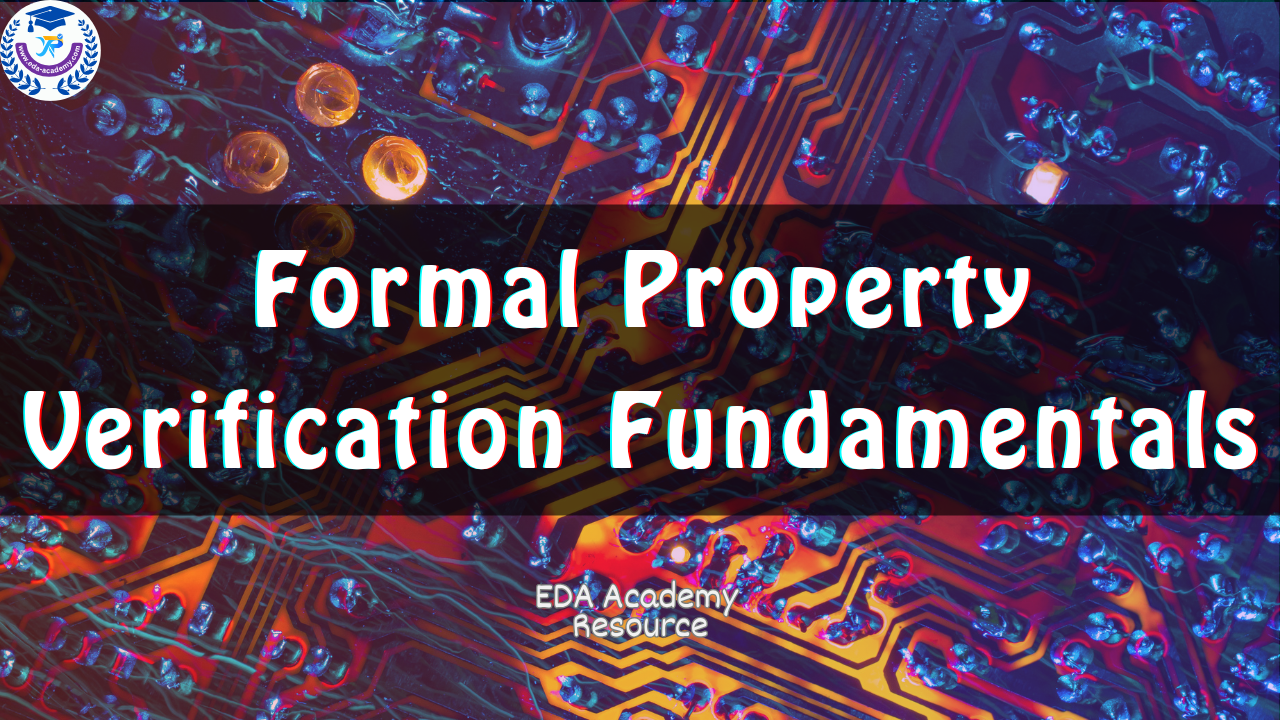Resource:
Formal Property Verification Fundamentals (English)
Formal Property Verification (FPV) applies exhaustive analysis to ensure that a design adheres to its specification under all legal conditions. By defining safety and liveness properties using SystemVerilog Assertions or similar languages, FPV replaces stimulus-dependent testing with logic-driven proof. The process relies on rigorous property definition, formal-friendly structural modeling, and exhaustive state-space traversal. FPV enhances observability, detects unreachable states, identifies dead logic, and offers structured signoff paths. When used with simulation, FPV provides comprehensive verification by closing gaps left by stimulus-based methods and ensuring correctness beyond traditional testbench reach.
Purchase
Our course syllabus is regularly updated to reflect the latest advancements and best practices in the field. For individually purchased courses or resources with lifetime access, students can always access the content and receive updates for free. For members, all member-free courses and resources — including future updates — are accessible during the active subscription period. This ensures that both lifetime purchasers and active members can benefit from the most relevant and up-to-date content.
Created by EDA Academy
English
Last updated June 2025

Resource: Formal Property Verification Fundamentals (English)
USD $199.9
-65%Today
$69.9
One-time Purchase
& Lifetime Access
What you will get:
1.3 Hours of Immersive, High-Quality Video Lessons
Professionally produced and delivered by our expert team, covering core concepts and practical demonstrations, with step-by-step explanations and real-life examples to help you efficiently absorb knowledge and apply it immediately in a short time.
Certificate of completion
Upon successful completion of the course, you will receive an official certificate issued by EDA Academy, adding value to your resume and career development.
Access on mobile and computer
The course can be viewed anytime on mobile phones, tablets, and computers, allowing you to learn easily whether at the office, at home, or on the go.
Ongoing support from EDA Academy
After the course ends, you will continue to receive ongoing support from our team to help you consolidate knowledge and solve practical problems.
Further learning plan
Provides you with follow-up learning paths and recommended resources, enabling you to continue improving your skills and expanding your career development based on what you have learned.
Resource Catalogue
Description
Formal Property Verification operates on the principle of mathematically proving that a digital circuit satisfies predefined behavioral expectations for all legal inputs and state transitions. These expectations are expressed as formal properties, typically encoded in SystemVerilog Assertions (SVA), which describe the required safety and liveness behaviors of the system. Safety properties assert that certain undesirable behaviors never occur, while liveness properties ensure that desired events eventually happen. FPV replaces reliance on functional stimulus with rigorous logic evaluation, removing randomness and delivering completeness through automated proof engines.
Property quality and completeness form the foundation of successful FPV. A well-defined property set allows formal tools to explore a state space exhaustively and determine conclusively whether the design conforms to its specification. This drives a shift from simulation-style coverage metrics to specification-driven verification metrics. Properties act as both verification goals and design documentation, capturing assumptions, corner-case expectations, and timing dependencies with precision. Proper layering of Boolean expressions, sequences, and directives ensures scalability and manageability of the property framework, while modular property sets support reuse and abstraction.
FPV operates efficiently on control logic, arbiters, protocol checkers, power state logic, and error-handling mechanisms. These structures are well suited for formal engines due to their deterministic behavior and limited state space. FPV enables deeper observability by automatically exploring legal conditions that may not be triggered during testbench simulation. This makes it especially effective at exposing unreachable states, dead code, and edge-case timing bugs that would otherwise be missed. In datapath-heavy or highly nonlinear designs, FPV can be complemented with simulation for broader test coverage.
An effective FPV testbench includes not only the property set but also assumptions, environmental constraints, interface abstractions, and auxiliary bindings to simplify state exploration. Inputs and outputs are managed symbolically, and controllability is established through helper modules or abstract modeling techniques. The result of each formal run is analyzed to classify as pass, fail, inconclusive, or bounded. Formal complexity is measured in state depth, constraint interaction, and module interdependencies. Reduction techniques include assertion partitioning, modular abstraction, and temporal slicing to optimize performance.
FPV supports formal signoff through rigorous completeness analysis and property-driven coverage reports. Two main signoff approaches exist: full-prove signoff, which requires all properties to be proven or bounded; and coverage-driven signoff, which emphasizes comprehensive verification guided by property hits and formal coverage goals. Combining FPV with simulation closes coverage gaps and enhances the confidence in design correctness. FPV is widely adopted in domains demanding high assurance, including SoC control fabrics, low-power mode transitions, protocol adherence, and security feature enforcement. As complexity scales and signoff pressure increases, property-driven formal methods continue to gain prominence in verification flows.
We HATE spam. Your email address is 100% secure
The document will be emailed to you. Please check your Spam folder if it doesn’t appear in your inbox.
We HATE spam. Your email address is 100% secure
